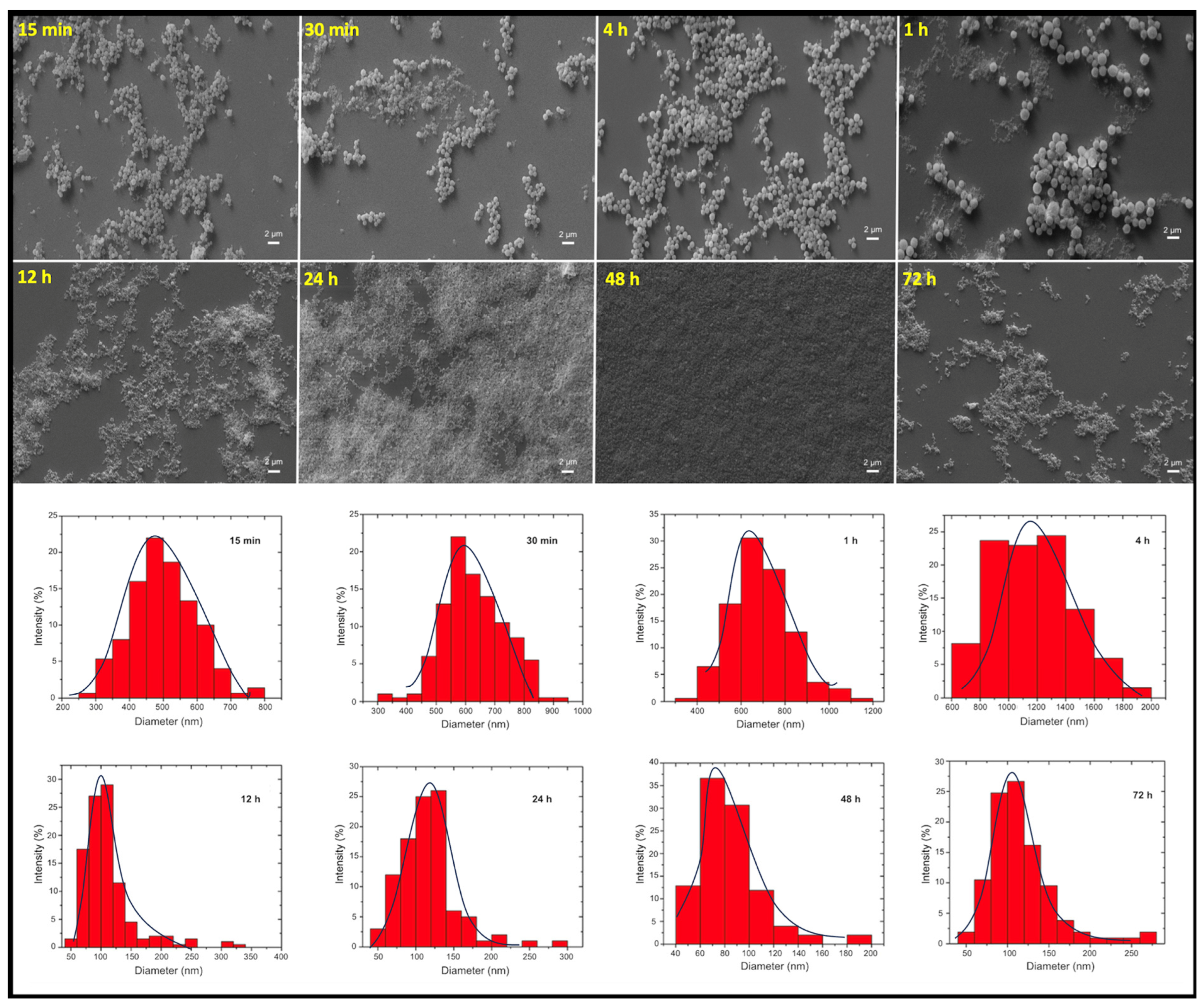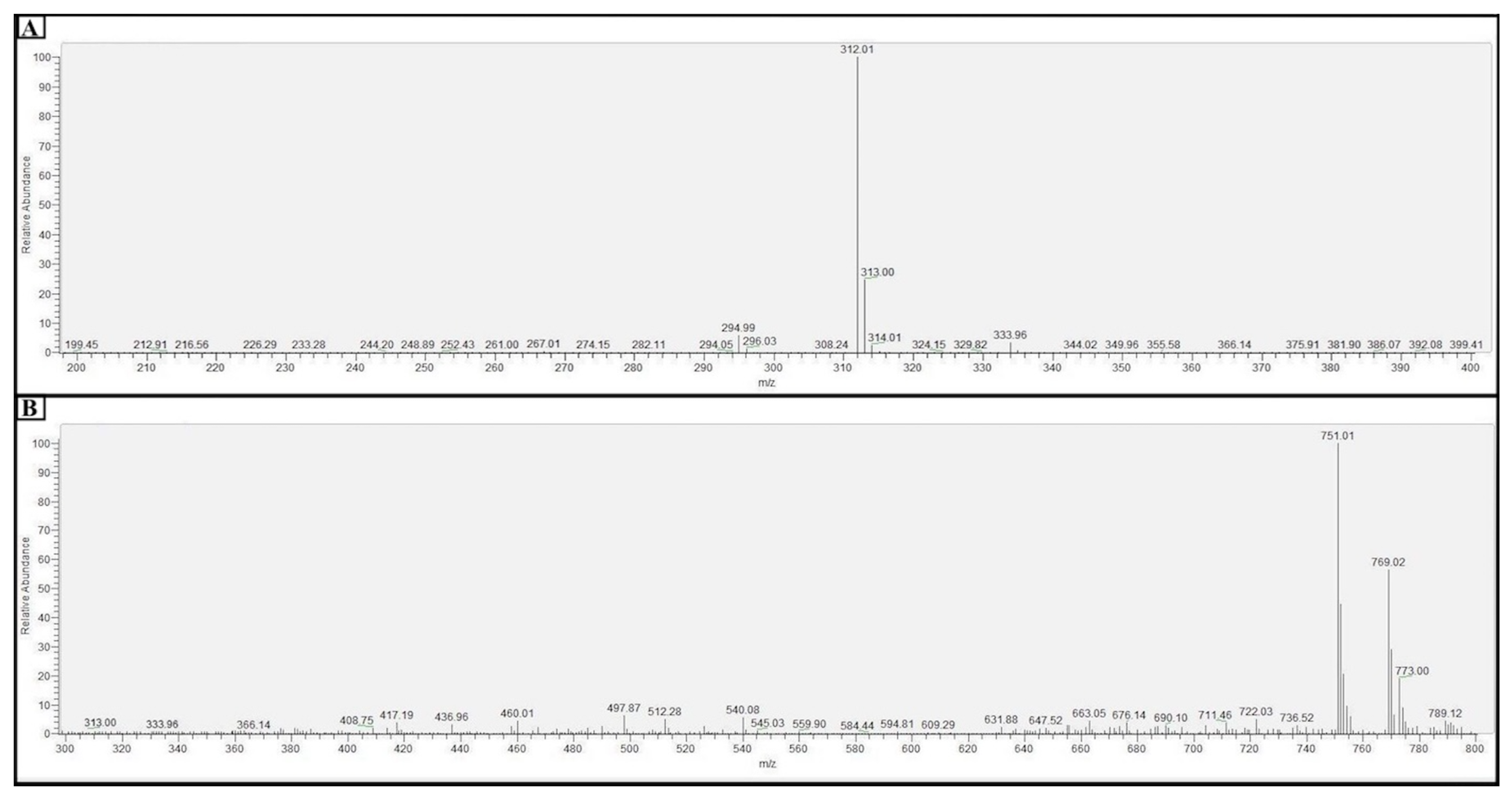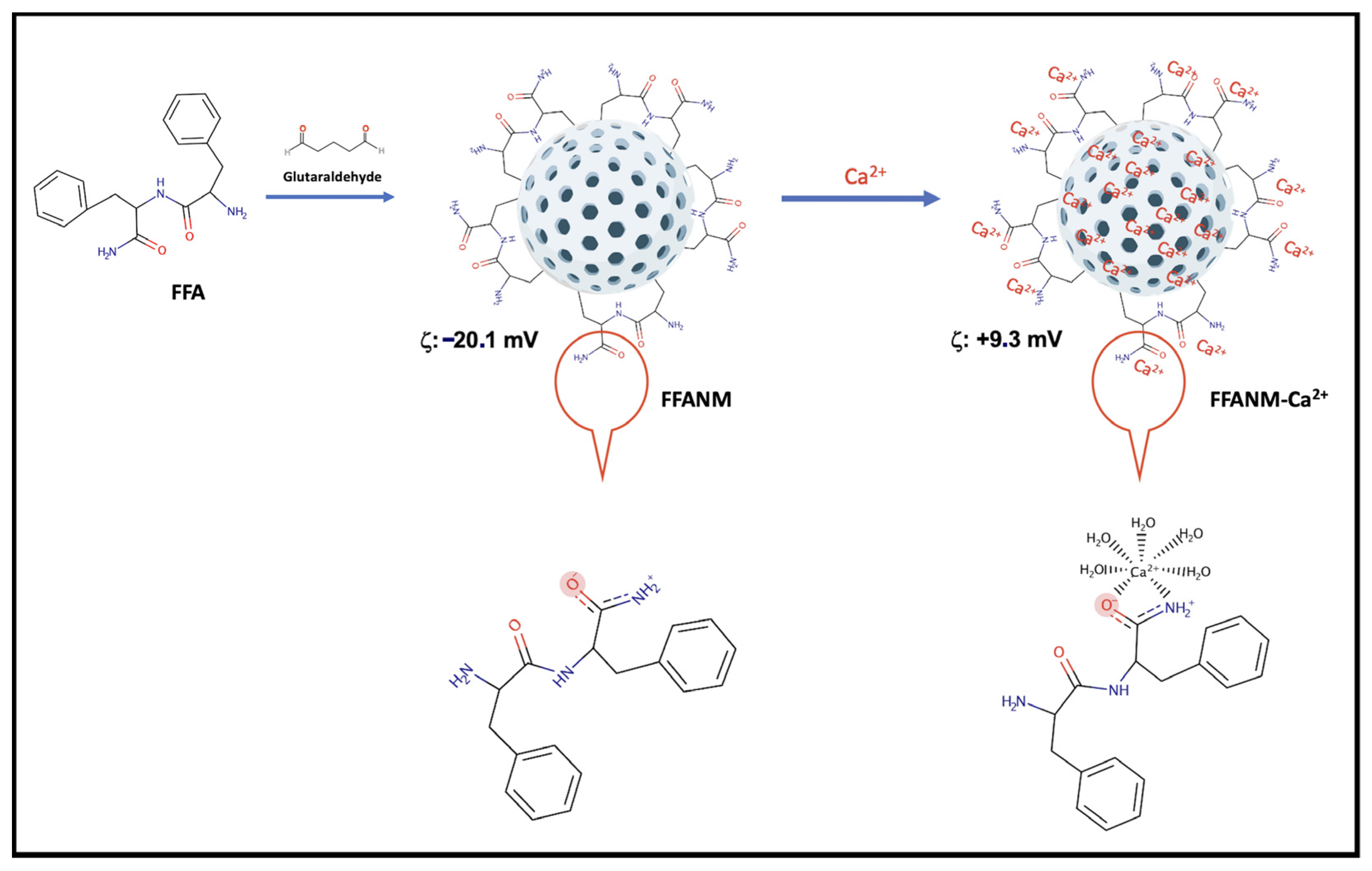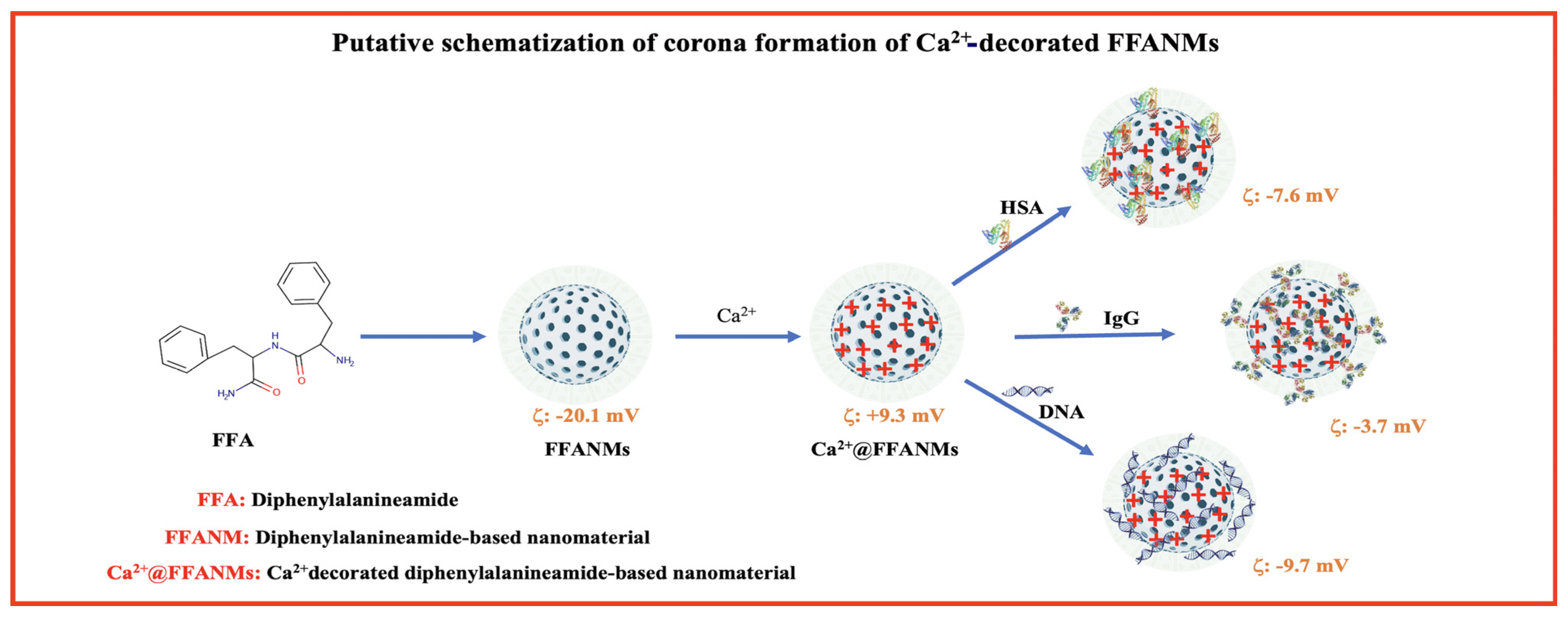Synthesis, Characterization, and Investigation of Corona Formation of Dipeptide-Based Nanomaterials
Abstract
1. Introduction
2. Experimental Parts
2.1. Materials
2.2. Methods
2.2.1. Synthesis of FFA-Based Nanomaterials
2.2.2. Decoration of FFA-Based Nanomaterials with Ca2+ Ions
2.2.3. Corona Formation Studies of FFA-Based Nanomaterials
2.2.4. Characterization of FFA-Based Nanomaterials
2.2.5. Cytotoxicity Studies of FFA-Based Nanomaterials
3. Results and Discussion
3.1. Characterization of FFA-Based Nanomaterials
3.2. Decoration of FFA-Based Nanomaterials with Ca2+ Ions
3.3. Corona Formation Studies of FFA-Based Nanomaterials
3.4. Cytotoxicity Studies of FFA-Based Nanomaterials
4. Conclusions
Supplementary Materials
Author Contributions
Funding
Institutional Review Board Statement
Informed Consent Statement
Data Availability Statement
Conflicts of Interest
References
- Barhoum, A.; García-Betancourt, M.L.; Jeevanandam, J.; Hussien, E.A.; Mekkawy, S.A.; Mostafa, M.; Omran, M.M.; S. Abdalla, M.; Bechelany, M. Review on Natural, Incidental, Bioinspired, and Engineered Nanomaterials: History, Definitions, Classifications, Synthesis, Properties, Market, Toxicities, Risks, and Regulations. Nanomaterials 2022, 12, 177. [Google Scholar] [CrossRef] [PubMed]
- Bozdoğan, B.; Akbal, Ö.; Çelik, E.; Türk, M.; Denkbaş, E.B. Novel Layer-by-Layer Self-Assembled Peptide Nanocarriers for SiRNA Delivery. RSC Adv. 2017, 7, 47592–47601. [Google Scholar] [CrossRef]
- Zhang, H.; Fei, J.; Yan, X.; Wang, A.; Li, J. Enzyme-responsive Release of Doxorubicin from Monodisperse Dipeptide-based Nanocarriers for Highly Efficient Cancer Treatment in Vitro. Adv. Funct. Mater. 2015, 25, 1193–1204. [Google Scholar] [CrossRef]
- Rizvi, S.A.A.; Saleh, A.M. Applications of Nanoparticle Systems in Drug Delivery Technology. Saudi Pharm. J. 2018, 26, 64–70. [Google Scholar] [CrossRef]
- Sun, B.; Wang, L.; Li, Q.; He, P.; Liu, H.; Wang, H.; Yang, Y.; Li, J. Bis (Pyrene)-Doped Cationic Dipeptide Nanoparticles for Two-Photon-Activated Photodynamic Therapy. Biomacromolecules 2017, 18, 3506–3513. [Google Scholar] [CrossRef] [PubMed]
- Ma, K.; Xing, R.; Jiao, T.; Shen, G.; Chen, C.; Li, J.; Yan, X. Injectable Self-Assembled Dipeptide-Based Nanocarriers for Tumor Delivery and Effective in Vivo Photodynamic Therapy. ACS Appl. Mater. Interfaces 2016, 8, 30759–30767. [Google Scholar] [CrossRef] [PubMed]
- Li, S.; Liu, Y.; Xing, R.; Yan, X. Covalently Assembled Dipeptide Nanoparticles with Adjustable Fluorescence Emission for Multicolor Bioimaging. ChemBioChem 2019, 20, 555–560. [Google Scholar] [CrossRef] [PubMed]
- Noma, S.A.A.; Ulu, A.; Acet, Ö.; Sanz, R.; Sanz-Pérez, E.S.; Odabaşı, M.; Ateş, B. Comparative Study of ASNase Immobilization on Tannic Acid-Modified Magnetic Fe3O4/SBA-15 Nanoparticles to Enhance Stability and Reusability. New J. Chem. 2020, 44, 4440–4451. [Google Scholar] [CrossRef]
- Önal, B.; Acet, Ö.; Sanz, R.; Sanz-Pérez, E.S.; Erdönmez, D.; Odabaşı, M. Co-Evaluation of Interaction Parameters of Genomic and Plasmid DNA for a New Chromatographic Medium. Int. J. Biol. Macromol. 2019, 141, 1183–1190. [Google Scholar] [CrossRef] [PubMed]
- Acet, Ö.; Önal, B.; Sanz, R.; Sanz-Pérez, E.S.; Erdönmez, D.; Odabaşi, M. Preparation of a New Chromatographic Media and Assessment of Some Kinetic and Interaction Parameters for Lysozyme. J. Mol. Liq. 2019, 276, 480–487. [Google Scholar] [CrossRef]
- Zhang, C.; Yan, L.; Wang, X.; Zhu, S.; Chen, C.; Gu, Z.; Zhao, Y. Progress, Challenges, and Future of Nanomedicine. Nano Today 2020, 35, 101008. [Google Scholar] [CrossRef]
- Agnihotri, T.G.; Alexander, A.; Agrawal, M.; Dubey, S.K.; Jain, A. In Vitro-in Vivo Correlation in Nanocarriers: From Protein Corona to Therapeutic Implications. J. Control. Release 2023, 354, 794–809. [Google Scholar] [CrossRef] [PubMed]
- Acet, Ö.; Shcharbin, D.; Zhogla, V.; Kirsanov, P.; Halets-Bui, I.; Acet, B.Ö.; Gök, T.; Bryszewska, M.; Odabaşı, M. Dipeptide Nanostructures: Synthesis, Interactions, Advantages and Biomedical Applications. Colloids Surf. B Biointerfaces 2022, 222, 113031. [Google Scholar] [CrossRef]
- Yıldırım, M.; Acet, Ö.; Yetkin, D.; Acet, B.Ö.; Karakoç, V.; Odabası, M. Anti-Cancer Activity of Naringenin Loaded Smart Polymeric Nanoparticles in Breast Cancer. J. Drug Deliv. Sci. Technol. 2022, 74, 103552. [Google Scholar] [CrossRef]
- Correa, S.; Dreaden, E.C.; Gu, L.; Hammond, P.T. Engineering Nanolayered Particles for Modular Drug Delivery. J. Control. Release 2016, 240, 364–386. [Google Scholar] [CrossRef] [PubMed]
- Alkekhia, D.; Hammond, P.T.; Shukla, A. Layer-by-Layer Biomaterials for Drug Delivery. Annu. Rev. Biomed. Eng. 2020, 22, 1–24. [Google Scholar] [CrossRef] [PubMed]
- Zhang, P.; Chen, D.; Li, L.; Sun, K. Charge Reversal Nano-Systems for Tumor Therapy. J. Nanobiotechnol. 2022, 20, 31. [Google Scholar] [CrossRef]
- Boehnke, N.; Dolph, K.J.; Juarez, V.M.; Lanoha, J.M.; Hammond, P.T. Electrostatic Conjugation of Nanoparticle Surfaces with Functional Peptide Motifs. Bioconjug. Chem. 2020, 31, 2211–2219. [Google Scholar] [CrossRef] [PubMed]
- Lv, H.; Zhang, S.; Wang, B.; Cui, S.; Yan, J. Toxicity of Cationic Lipids and Cationic Polymers in Gene Delivery. J. Control. Release 2006, 114, 100–109. [Google Scholar] [CrossRef] [PubMed]
- Moghimi, S.M.; Symonds, P.; Murray, J.C.; Hunter, A.C.; Debska, G.; Szewczyk, A. A Two-Stage Poly (Ethylenimine)-Mediated Cytotoxicity: Implications for Gene Transfer/Therapy. Mol. Ther. 2005, 11, 990–995. [Google Scholar] [CrossRef] [PubMed]
- Choi, E.; Lee, J.; Kwon, I.C.; Lim, D.-K.; Kim, S. Cumulative Directional Calcium Gluing between Phosphate and Silicate: A Facile, Robust and Biocompatible Strategy for SiRNA Delivery by Amine-Free Non-Positive Vector. Biomaterials 2019, 209, 126–137. [Google Scholar] [CrossRef]
- Pal, V.K.; Roy, S. Cooperative Metal Ion Coordination to the Short Self-Assembling Peptide Promotes Hydrogelation and Cellular Proliferation. Macromol. Biosci. 2022, 22, 2100462. [Google Scholar] [CrossRef]
- da Silveira, G.D.; Izabelle, C.; Saubamea, B.; Varenne, A.; d’Orlyé, F. Insights into Diphenylalanine Peptide Self-Assembled Nanostructures for Integration as Nanoplatforms in Analytical and Medical Devices. Int. J. Pharm. 2023, 648, 123559. [Google Scholar] [CrossRef]
- Lima, T.; Bernfur, K.; Vilanova, M.; Cedervall, T. Understanding the Lipid and Protein Corona Formation on Different Sized Polymeric Nanoparticles. Sci. Rep. 2020, 10, 1129. [Google Scholar] [CrossRef] [PubMed]
- Richtering, W.; Alberg, I.; Zentel, R. Nanoparticles in the Biological Context: Surface Morphology and Protein Corona Formation. Small 2020, 16, 2002162. [Google Scholar] [CrossRef] [PubMed]
- Kopac, T. Protein Corona, Understanding the Nanoparticle–Protein Interactions and Future Perspectives: A Critical Review. Int. J. Biol. Macromol. 2021, 169, 290–301. [Google Scholar] [CrossRef] [PubMed]
- Mishra, R.K.; Ahmad, A.; Vyawahare, A.; Alam, P.; Khan, T.H.; Khan, R. Biological Effects of Formation of Protein Corona onto Nanoparticles. Int. J. Biol. Macromol. 2021, 175, 1–18. [Google Scholar] [CrossRef]
- Tenzer, S.; Docter, D.; Kuharev, J.; Musyanovych, A.; Fetz, V.; Hecht, R.; Schlenk, F.; Fischer, D.; Kiouptsi, K.; Reinhardt, C. Rapid Formation of Plasma Protein Corona Critically Affects Nanoparticle Pathophysiology. In Nano-Enabled Medical Applications; Jenny Stanford Publishing: Singapore, 2020; pp. 251–278. [Google Scholar]
- Cagliani, R.; Gatto, F.; Bardi, G. Protein Adsorption: A Feasible Method for Nanoparticle Functionalization? Materials 2019, 12, 1991. [Google Scholar] [CrossRef] [PubMed]
- Furumoto, K.; Yokoe, J.-I.; Ogawara, K.; Amano, S.; Takaguchi, M.; Higaki, K.; Kai, T.; Kimura, T. Effect of Coupling of Albumin onto Surface of PEG Liposome on Its in Vivo Disposition. Int. J. Pharm. 2007, 329, 110–116. [Google Scholar] [CrossRef]
- Peng, Q.; Zhang, S.; Yang, Q.; Zhang, T.; Wei, X.-Q.; Jiang, L.; Zhang, C.-L.; Chen, Q.-M.; Zhang, Z.-R.; Lin, Y.-F. Preformed Albumin Corona, a Protective Coating for Nanoparticles Based Drug Delivery System. Biomaterials 2013, 34, 8521–8530. [Google Scholar] [CrossRef] [PubMed]
- Tonigold, M.; Simon, J.; Estupiñán, D.; Kokkinopoulou, M.; Reinholz, J.; Kintzel, U.; Kaltbeitzel, A.; Renz, P.; Domogalla, M.P.; Steinbrink, K. Pre-Adsorption of Antibodies Enables Targeting of Nanocarriers despite a Biomolecular Corona. Nat. Nanotechnol. 2018, 13, 862–869. [Google Scholar] [CrossRef]
- Vistica, D.T.; Skehan, P.; Scudiero, D.; Monks, A.; Pittman, A.; Boyd, M.R. Tetrazolium-Based Assays for Cellular Viability: A Critical Examination of Selected Parameters Affecting Formazan Production. Cancer Res. 1991, 51, 2515–2520. [Google Scholar]
- Berridge, M.V.; Tan, A.S. Characterization of the Cellular Reduction of 3-(4, 5-Dimethylthiazol-2-Yl)-2, 5-Diphenyltetrazolium Bromide (MTT): Subcellular Localization, Substrate Dependence, and Involvement of Mitochondrial Electron Transport in MTT Reduction. Arch. Biochem. Biophys. 1993, 303, 474–482. [Google Scholar] [CrossRef] [PubMed]
- Raval, N.; Maheshwari, R.; Kalyane, D.; Youngren-Ortiz, S.R.; Chougule, M.B.; Tekade, R.K. Importance of Physicochemical Characterization of Nanoparticles in Pharmaceutical Product Development. In Basic Fundamentals of Drug Delivery; Elsevier: Amsterdam, The Netherlands, 2019; pp. 369–400. [Google Scholar]
- Schöttler, S.; Becker, G.; Winzen, S.; Steinbach, T.; Mohr, K.; Landfester, K.; Mailänder, V.; Wurm, F.R. Protein Adsorption Is Required for Stealth Effect of Poly (Ethylene Glycol)-and Poly (Phosphoester)-Coated Nanocarriers. Nat. Nanotechnol. 2016, 11, 372–377. [Google Scholar] [CrossRef]
- Gebauer, J.S.; Malissek, M.; Simon, S.; Knauer, S.K.; Maskos, M.; Stauber, R.H.; Peukert, W.; Treuel, L. Impact of the Nanoparticle–Protein Corona on Colloidal Stability and Protein Structure. Langmuir 2012, 28, 9673–9679. [Google Scholar] [CrossRef]
- Dai, Q.; Yan, Y.; Guo, J.; Björnmalm, M.; Cui, J.; Sun, H.; Caruso, F. Targeting Ability of Affibody-Functionalized Particles Is Enhanced by Albumin but Inhibited by Serum Coronas. ACS Macro Lett. 2015, 4, 1259–1263. [Google Scholar] [CrossRef]
- Nel, A.E.; Mädler, L.; Velegol, D.; Xia, T.; Hoek, E.; Somasundaran, P.; Klaessig, F.; Castranova, V.; Thompson, M. Understanding Biophysicochemical Interactions at the Nano–Bio Interface. Nat. Mater. 2009, 8, 543–557. [Google Scholar] [CrossRef] [PubMed]
- Kopp, M.; Kollenda, S.; Epple, M. Nanoparticle–Protein Interactions: Therapeutic Approaches and Supramolecular Chemistry. Acc. Chem. Res. 2017, 50, 1383–1390. [Google Scholar] [CrossRef] [PubMed]
- Kim, W.; Ly, N.K.; He, Y.; Li, Y.; Yuan, Z.; Yeo, Y. Protein Corona: Friend or Foe? Co-Opting Serum Proteins for Nanoparticle Delivery. Adv. Drug Deliv. Rev. 2023, 192, 114635. [Google Scholar] [CrossRef]
- Kiselev, M.A.; IuA, G.; Dobretsov, G.E.; Komarova, M.N. Size of a Human Serum Albumin Molecule in Solution. Biofizika 2001, 46, 423–427. [Google Scholar]







| GA Treatment Duration | FFANM Size (nm) |
|---|---|
| 15 min | 500.4 ± 44.2 |
| 30 min | 631.5 ± 38.4 |
| 1 h | 686.9 ± 28.9 |
| 4 h | 117.9 ± 32.7 |
| 12 h | 110.9 ± 22.8 |
| 24 h | 116.5 ± 23.1 |
| 48 h | 87.9 ± 20.4 |
| 72 h | 117.1 ± 35.3 |
| FFANMs | FFANMs-Ca2+ 0.5 mg/mL Ca2+) | FFANMs-Ca2+ (1.0 mg/mL Ca2+) | FFANMs-Ca2+ (2.0 mg/mL Ca2+) | |
|---|---|---|---|---|
| Zeta (mV) | −20.1 | −10.5 | +6.6 | +9.3 |
| CHSA (mg/mL) | FFANMs/HSA (g/g) | Ca2+@FFANMs/HSA (g/g) |
|---|---|---|
| 35 | 16.8 | 17.8 |
| CIgG (mg/mL) | FFANMs/IgG (g/g) | Ca2+@FFANMs/IgG (g/g) |
| 7 | 12.8 | 12.6 |
| CDNA (mg/mL) | FFANMs/DNA (mg/g) | Ca2+@FFANMs/DNA (mg/g) |
| 0.035 | 14.7 | 17.5 |
Disclaimer/Publisher’s Note: The statements, opinions and data contained in all publications are solely those of the individual author(s) and contributor(s) and not of MDPI and/or the editor(s). MDPI and/or the editor(s) disclaim responsibility for any injury to people or property resulting from any ideas, methods, instructions or products referred to in the content. |
© 2024 by the authors. Licensee MDPI, Basel, Switzerland. This article is an open access article distributed under the terms and conditions of the Creative Commons Attribution (CC BY) license (https://creativecommons.org/licenses/by/4.0/).
Share and Cite
Dikici, E.; Önal Acet, B.; Bozdoğan, B.; Acet, Ö.; Halets-Bui, I.; Shcharbin, D.; Odabaşı, M. Synthesis, Characterization, and Investigation of Corona Formation of Dipeptide-Based Nanomaterials. Materials 2025, 18, 108. https://doi.org/10.3390/ma18010108
Dikici E, Önal Acet B, Bozdoğan B, Acet Ö, Halets-Bui I, Shcharbin D, Odabaşı M. Synthesis, Characterization, and Investigation of Corona Formation of Dipeptide-Based Nanomaterials. Materials. 2025; 18(1):108. https://doi.org/10.3390/ma18010108
Chicago/Turabian StyleDikici, Emrah, Burcu Önal Acet, Betül Bozdoğan, Ömür Acet, Inessa Halets-Bui, Dzmitry Shcharbin, and Mehmet Odabaşı. 2025. "Synthesis, Characterization, and Investigation of Corona Formation of Dipeptide-Based Nanomaterials" Materials 18, no. 1: 108. https://doi.org/10.3390/ma18010108
APA StyleDikici, E., Önal Acet, B., Bozdoğan, B., Acet, Ö., Halets-Bui, I., Shcharbin, D., & Odabaşı, M. (2025). Synthesis, Characterization, and Investigation of Corona Formation of Dipeptide-Based Nanomaterials. Materials, 18(1), 108. https://doi.org/10.3390/ma18010108







